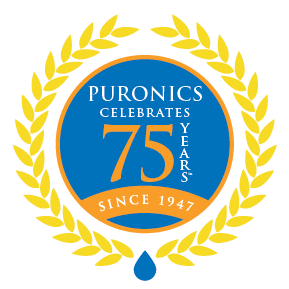Last Updated on August 26, 2021
Hard water is something that nobody wants to live with. It means your water contains high concentration levels of certain minerals, causing problems such as reduced appliance efficiency, dry skin and many other undesirable effects. Are you experiencing any of these issues? Then it is time to understand exactly what hard water is and how a water softener works.
What is Hard Water?
Hardness refers to a high concentration of minerals in water, mostly calcium and magnesium. While not harmful for your health, hard water wreaks havoc on your home and body. It causes scale to build up in pipes and appliances, restricting flow and causing damage. The minerals cause soap to form an insoluble curd instead of a lather, which means you have to use significantly more soap and cleaning supplies. Hard water leaves spots and streaks on dishes, silverware and glass. It also leaves behind a residue on sinks and tubs, requiring a lot of effort to clean. The soap residue left over after this mineral interaction also damages your skin and hair.
Water picks up these minerals as it flows through the ground. About 85% of the United States has hard water. The term “hard water” originally came from the fact that it is “hard” to wash anything because soap doesn’t lather easily in water with high mineral content.
Hardness is usually measured in grains per gallon (gpg), which is equivalent to 17.1 milligrams per liter (mg/L). Less than 1 gpg is considered soft, 1 to 3.5 is slightly hard, 3.5 to 7 is moderately hard and 7 to 10.5 is hard. Anything over 10.5 gpg is very hard.
How Does a Water Softener Work?
A water softener works by removing hardness minerals through a method called ion exchange. Inside of a tall media tank, usually made of fiberglass or stainless steel, there are a layer of tiny plastic beads, called ion exchange resin. These resin beads have a negative charge, so positive ions bond to them.
The resin beads start out with sodium or potassium ions attached. (These ions come from the salt in a backflush tank, which we’ll discuss in a moment.) As hard water flows through, calcium and magnesium ions take the place of the sodium or potassium ions because they have a stronger positive charge. The resin can only hold a certain amount of hardness ions, so when it reaches its capacity, it needs to be regenerated, or cleaned of hardness ions and “refilled” with sodium or potassium ions from the salt in the backflush tank. Different control valves have different ways of detecting when the resin has reached its capacity, and they tell the system to regenerate.
The regeneration process has several phases. First, water flows through the tank containing the resin, removing sediment and dirt. Then, a highly concentrated brine solution of sodium chloride or potassium chloride from the backflush tank flows through the resin media tank, displacing the calcium and magnesium ions and replacing them with fresh sodium or potassium ions. After this, the leftover solution and the calcium and magnesium ions are flushed down the drain. Once this cycle is complete, the system can soften water again.
How do Puronics Water Softeners Work?
Most Puronics water softeners are also water filters, so they have multiple functions. We use SilverShield® HYgene® or ChloroShield™ Clearess® to provide enhanced filtration plus silica gravel to polish the water.
One of the benefits of Puronics softeners is that they are very efficient with salt and water usage. Our iGen® valve keeps track of water consumption so that the system only regenerates when needed. Another benefit is that the systems have a high flow rate, which means you won’t notice a decrease in flow even when you’re running multiple appliances and taps.
Is it Safe to Drink from a Water Softener?
If the water coming into your home is safe to drink, then yes. However, if your water contains harmful contaminants, you should look into additional treatment methods to address those, such as reverse osmosis. A water softener will improve the taste of water, but if you want to remove the chlorine taste and odor, you need a water filter that uses activated carbon, like a Puronics system.
Do I Have to Use Salt?
Yes. Salt-free water softeners are a myth. (If you see one marketed as such, it’s actually just a type of water conditioner.) A water softener cannot regenerate its resin beads without salt — whether it’s sodium chloride or potassium chloride. If it doesn’t regenerate, it won’t be able to soften your water. The salt from a water softener adds a very small amount of sodium or potassium to your water. The equivalent amount of sodium is about as much as what is in a slice of white bread for every gallon of water.
If you’re concerned about the sodium, you can install a reverse osmosis system, which will remove the sodium, under your kitchen sink for drinking and cooking, or use potassium chloride. Another option is a salt-free filtration system, which can prevent scale buildup but won’t provide all the other benefits of soft water. Read more about Salt-Based vs. Salt-Free Water Conditioners.
Hard water is a common problem in many households. A quality water softener will alleviate the problems associated with hard water. By investing in a good softener, you can get 30 or more years of soft water throughout your home. If you have additional questions about water softeners or any of our products, please contact Puronics or your local Authorized Dealer.
© Copyright 2020 Puronics, Inc. All rights reserved.

 Puronics, Incorporated
Puronics, Incorporated




Thanks for explaining that water softeners use resin beds to remove hardness. I’m thinking about getting a whole home water system. It’ll hopefully be really beneficial for me and my family.
Thanks for mentioning that a water softener removed hard minerals through ion exchange. My master shower has a ton of hard water stains, and it’s driving me crazy. At this point, I think it would be good to install a water softener instead of always cleaning the hard water scum.